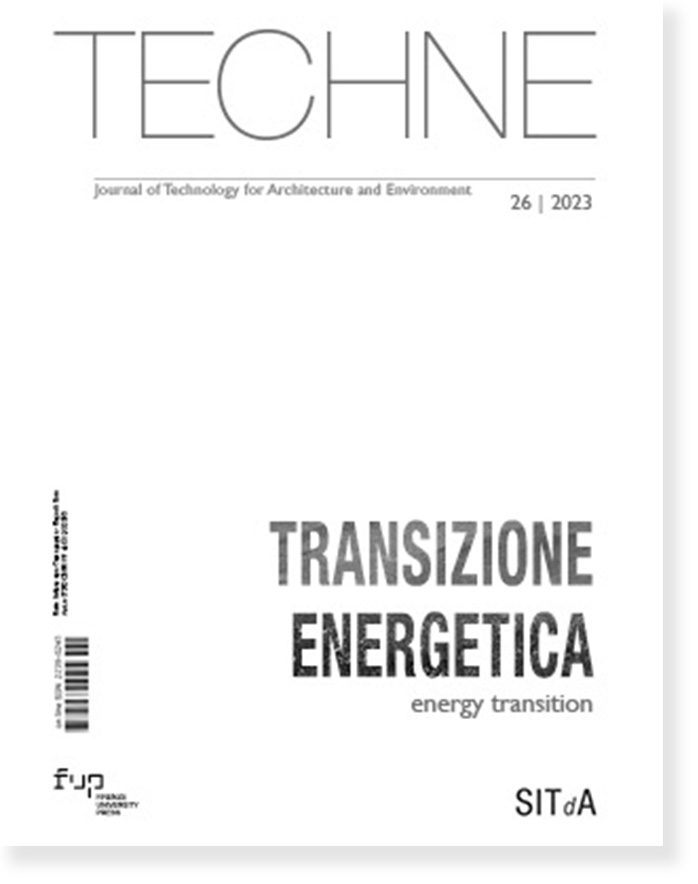Published 2023-10-31
Keywords
- Decarbonisation,
- Energy Communities,
- Co-Design,
- Emerging Technologies,
- Living Lab
How to Cite
Copyright (c) 2023 Consuelo Nava, Giuseppe Mangano

This work is licensed under a Creative Commons Attribution 4.0 International License.
Abstract
In order to accelerate the “green and digital” transition and the achievement of carbon neutrality objectives, the EU has launched a profound transformation of the global energy system in the regions of member countries. In this context, the research project, which addresses the reduction in impacts from climate change through mitigation and adaptation processes and strategies, has the objective of activating a demonstration (Living Lab) in the SNAI pilot area “Grecanica” (RC). It envisages developing and transfering advanced sustainable technologies for “energy self-production of communities”, with processes enabled by technologies belonging to advanced systems for customised production and distributed generation from renewable sources, smart grids and digital flow management.
Downloads
References
Caramizaru, A. and Uihlein, A. (2020), JRC- Energy communities: an overview of energy and social innovation, EUR 30083 EN, Publications Office of the European Union, Luxembourg, ISBN 978-92-76-10713-2, doi:10.2760/180576, JRC119433.
De Santoli, L. (2011), Le Comunità dell’energia, Quodlibet, Macerata
E&S Group Polimi (2021), Electricity Market Report 2021, Collana Quaderni AIP, Politecnico Milano, ISBN 978 88 6493 066 4
European Commission (2018), Final Report of the High-Level Panel of the European Decarbonisation Pathways Initiative, Publications Office of the European Union, Luxembourg
Fan, Z., Cao J., Jamal, T. et al. (2022), “The role of ‘living laboratories’ in accelerating the energy system Decarbonization”, Energy Reports 8, 11858–11864
Hanna, R. (2017), “Community Renewables Innovation Lab. Energy Transition Platform Policy Briefing”, Spiral.Imperial.Ac.Uk, Vol. 22, No. November
IPCC, 2018-19: Global Warming of 1.5°C.An IPCC Special Report on the impacts of global warming of 1.5°C above pre-industrial levels and related global greenhouse gas emission pathways, in the context of strengthening the global response to the threat of climate change, sustainable development, and efforts to eradicate poverty, Cambridge University Press, Cambridge, UK and New York, NY, USA, 616 pp.https://doi.org/10.1017/9781009157940
Kampman, B., Blommerde J., and Afma M. (2016), The Potential of Energy Citizens in the European Union, Report Commissioned by Greenpeace
Marinakis, V., Papadopoulou, A.G., Psarras, J., “Local communities towards a sustainable energy future: Needs and priorities”. Int. J. Sustain. Energy 2015, 36, 296–312. https://doi.org/10.1080/14786451.2015.1018264
Roberts, J., Bodman F., and Rybski R. (2014), “Community Power; Model Legal Frameworks for Citizen-Owned”, Renewable Energy, Vol. 1, Vol. 1, ClientEarth, London
REN21 (2016), “Renewables 2016 Global Status Report. Key Findings 2016”, REN21 – Renewable Energy Policy Network, Paris
World Economic Forum (2023), “Global risks ranked by severity over the short and long term”, in WEF, The Global Risk Report, 18 th edit., ISBN-13: 978-2-940631-36-0






